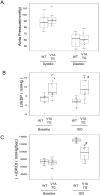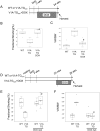Controlled and cardiac-restricted overexpression of the arginine vasopressin V1A receptor causes reversible left ventricular dysfunction through Gαq-mediated cell signaling
- PMID: 21747049
- PMCID: PMC3908781
- DOI: 10.1161/CIRCULATIONAHA.111.021352
Controlled and cardiac-restricted overexpression of the arginine vasopressin V1A receptor causes reversible left ventricular dysfunction through Gαq-mediated cell signaling
Abstract
Background: [Arg8]-vasopressin (AVP) activates 3 G-protein-coupled receptors: V1A, V2, and V1B. The AVP-V1A receptor is the primary AVP receptor in the heart; however, its role in cardiac homeostasis is controversial. To better understand AVP-mediated signaling in the heart, we created a transgenic mouse with controlled overexpression of the V1A receptor.
Methods and results: The V1A receptor transgene was placed under the control of the tetracycline-regulated, cardiac-specific α-myosin heavy chain promoter (V1A-TG). V1A-TG mice had a normal cardiac function phenotype at 10 weeks of age; however, by 24 weeks of age, tetracycline-transactivating factor/V1A-TG mouse hearts had reduced cardiac function, cardiac hypertrophy, and dilatation of the ventricular cavity. Contractile dysfunction was also observed in isolated adult cardiac myocytes. When V1A receptor transgene was induced to be expressed in adult mice (V1A-TG(Ind)), left ventricular dysfunction and dilatation were also seen, albeit at a later time point. Because the V1A receptor mediates cell signaling through Gα(q) protein, we blocked Gα(q) signaling by crossing tetracycline-transactivating factor/V1A mice with transgenic mice that expressed a small inhibitory peptide against Gα(q). Gα(q) blockade abrogated the development of the heart failure phenotype in tetracycline-transactivating factor/V1A-TG mice. The heart failure phenotype could be reversed by administration of doxycycline.
Conclusions: Our results demonstrate a role for V1A-mediated signaling in the development of heart failure and support a role for V1A blockade in the treatment of patients with elevated levels of vasopressin.
Figures







References
-
- Yamane Y. Plasma ADH level in patients with chronic congestive heart failure. Jpn Circ J. 968:745–759. - PubMed
-
- Goldsmith SR, Francis GS, Levine TB, Cowley AW, Jr, Cohn JN. Impaired response of plasma vasopressin to orthostatic stress in patients with congestive heart failure. J Am Coll Cardiol. 1983;2:1080–1083. - PubMed
-
- Szatalowicz VL, Arnold PE, Chaimovitz C, Bichet D, Berl T, Schrier RW. Radioimmunoassay of plasma arginine vasopressin in hyponatremic patients with congestive heart failure. N Engl J Med. 1981;305:263–266. - PubMed
-
- Kim JK, Michel JB, Soubrier F, Durr J, Corvol P, Schrier RW. Arginine vasopressin gene expression in chronic cardiac failure in rats. Kidney Int. 1990;38:818–822. - PubMed
-
- Muders F, Riegger GA, Bahner U, Palkovits M. The central vasopressinergic system in experimental left ventricular hypertrophy and dysfunction. Prog Brain Res. 2002;139:275–279. - PubMed
Publication types
MeSH terms
Substances
Grants and funding
- P30CA56036/CA/NCI NIH HHS/United States
- HL 075443/HL/NHLBI NIH HHS/United States
- HL 58672/HL/NHLBI NIH HHS/United States
- HL 085503/HL/NHLBI NIH HHS/United States
- P01 HL075443/HL/NHLBI NIH HHS/United States
- R01 HL061690/HL/NHLBI NIH HHS/United States
- R01 HL074854/HL/NHLBI NIH HHS/United States
- P01 HL091799/HL/NHLBI NIH HHS/United States
- R01 HL085503/HL/NHLBI NIH HHS/United States
- HL 74854/HL/NHLBI NIH HHS/United States
- HL 061690/HL/NHLBI NIH HHS/United States
- HL 091799-01/HL/NHLBI NIH HHS/United States
- R37 HL061690/HL/NHLBI NIH HHS/United States
- R01 HL058672/HL/NHLBI NIH HHS/United States
- P30 CA056036/CA/NCI NIH HHS/United States
LinkOut - more resources
Full Text Sources
Other Literature Sources
Molecular Biology Databases
Miscellaneous

